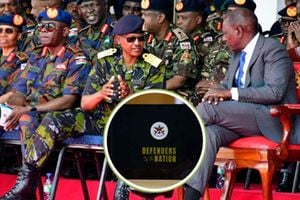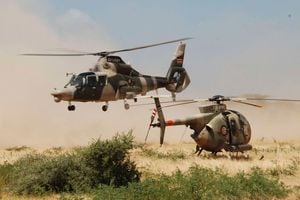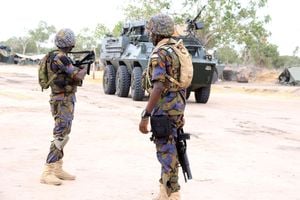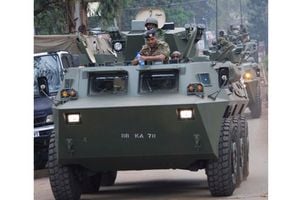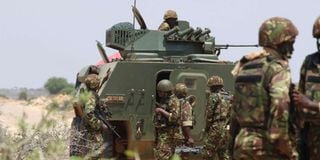
Kenya Defence Forces soldiers under Africa Union Mission in Somalia (Amisom) patrol Kismayo town on November 22, 2015.
As the Kenya Defence Forces (KDF) celebrate their 13th KDF Day on October 14, the troops are preparing to return home after the conclusion of their African Transition Mission In Somalia (ATMIS) tour in December.
That is if the African Union and the United Nations don’t include KDF in the newly formed African Union Support and Stabilization Mission (AUSSOM) that will take over the mandate after ATMIS’s exit.
“On KDF Day, we celebrate and commemorate the acts of valour and sacrifice of our soldiers,” said KDF’s Chief of Strategic Communications, Brig Paul Njuguna. “We have not forgotten the service personnel that were reported missing in action either. As a fraternity, we continually seek safe ways and means to bring them back home. We also remember those who have not returned to us. We shall never forget them nor tire in relentlessly pursuing avenues to get them back home.”
The 13-year presence in Somalia has seen KDF modernise and ramp up its equipment to effectively combat Al-Shabaab and other insurgents. While KDF had a well-established Air Force prior to October 2011, it has now embrace drones to detect and monitor Al-Shabaab movement.
In September 2015, Kenya reportedly ordered ScanEagle UAV systems for about Sh1 billion to supplement Aerovironment RQ-11 drones earlier ordered from the United States in 2012. The ScanEagle UAV drones are manufactured by Boeing affiliate Isintu.
So advanced in technology has KDF become that its engineers have reverse-engineered Israeli Aerostar drone christened TAI to its own suitability according to Military Africa, an online defence industry resource. Further, KDF is recognised as one of the East African countries’ militaries engaging in local manufacture of drones.
On the naval front, KDF has stepped into ship building and repair with the establishment of the Kenya Shipyard Limited. Regional countries recently brought their vessels to the Shipyard for repairs. It’s rebuilt the Lake Victoria-based Sh2.4 billion MV Uhuru, which was handed over to the Kenya Railways Corporation.
Because Kenyan troops have died since KDF’s incursion into Somalia on October 11, 2011, the military has made heroes’ monuments in several military bases to remember the lost lives.
Al-Shabaab attacks
Most of the soldiers died during the initial incursion into the unknown territory in challenging environment and during the Al-Shabaab attacks on Forward Operating Bases (FOB) in El-Adde, Gedo region on January 15, 2016 and the Kulbiyow attack a year later on January 27, 2017. The El-Adde attack remains the deadliest on the mission.
The attack led to a change of tack by KDF in securing its FOBs. While initially, most FOBs were secured by dry shrubs supplemented by trips, wires and watchtowers around the camps, KDF introduced deep trenches around all FOBs and manned armored tanks to support the sentries.
As a result, there have been no similar devastating attacks on any of the FOBs. On December 15, 2019, President Uhuru Kenyatta commissioned Modika Barracks in northern Kenya. It’s the home of the 6th Brigade. In October 2021, Kenyatta opened Manda Bay Naval base to secure Kenya’s territorial waters and protect the Lamu Port.
As an FOB, Manda played a key role in the capture of Kismayu port in September 2012. The base had been used as a launching pad for major counter-terrorism operations.
To further improve its battle readiness, KDF established the 17 Kenya Rifles based at Nyali Barracks on December 12, 2018. The 17th Kenya Rifles are also known as ‘Desert Rangers’, which was formed as a result of Kenya Army Commander’s Medium term modernisation programme.
In December 2021, KDF established the 19th Kenya Rifles unit also based at Nyali. The unit is commonly referred to as ‘Ash Warrior’s because of their grey colour insignia. However, of great importance and pride to KDF since the incursion into Somalia, has been the establishment of the Special Operations Regiment that houses all Kenya Army’s Special and Commando units.
These units, tasked with countering insurgency and enemy infiltration undergo training at the Special Operation Training School (SOTS), Gilgil before proceeding for advanced courses outside the country.
The Special Forces units consist of the 20th Parachute Battalion, 30th Special Forces, 40th Ranger Strike Force, 30th Special Forces and the 40th Ranger Strike Force were extensively used during ‘Operation Linda Nchi’ and the historic amphibious landing and capture of Kismayu port.
The same units were deployed in Beni, Democratic Republic of Congo to help FARDC combat Allied Democratic Forces rebels.
Stranded pilots
Recently, KDF launched the Long Range Surveillance Group, which is tasked with reconnaissance deep within enemy lines. The unit has been deployed to Somalia’s Gedo region. To rescue stranded pilots within enemy positions, Kenya Air Force established the Laikipia-based Rapid Deployment Unit (RDU). This is after it lost a pilot whose aircraft developed technical problems that resulted in a crash in Southern Somalia. Another specialised unit is the Manda-based Special Boat Unit (SBU), which is tasked with interceptions and special operations in the high seas.
The SBU works with the Clearance Diving Unit, which is mandated with controlling maritime traffic between Kenya and Somalia. To deal with the 13 years of trauma and stress affecting the KDF troops deployed in war torn Somalia, KDF established a wellness centre at Lang’ata Barracks to cater for returning troops suffering from the new phenomenon of Post-Traumatic Stress Disorder (PSTD).
A Compensation and Welfare branch has also been established to deal with the challenges faced by troops returning from combat. To cater for those who have honourably served in the military, KDF has pushed for the enactment of the Veterans Act which established the regulatory and institutional framework for the management of military veterans’ affairs for the provision of benefits to military veterans and military veterans’ dependents. The Act also establishes the Dependents Education Fund and for other connected purposes.
The Act describes a military veteran as a person who has served in Kenya Defence Forces, became a member of the Kenya Armed Forces after 1963, served in the King’s African Rifles before 1963, has completed service in the Armed Forces of Kenya Defence Forces, receives pension from the Armed Forces or the Kenya Defence Forces and has not been dishonorably discharged from military service. “We have learnt many lessons in Somalia, although we have unfortunately suffered casualties as well, but of great significance is the maintenance of our resolve and mandate, that is to protect and defend Kenya’s territorial integrity,” said Brig Njuguna.

